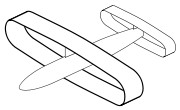- Closed wing
-
A closed wing is a non-planar wing planform concept. The term closed wing encompasses a number of designs, including the annular wing (commonly known as the cylindrical or ring wing), the joined wing, and the box wing. A closed wing can be thought of as the maximum expression of a wingtip device, which has the aim of eliminating the influence of the wingtip vortices which occur at the tips of conventional wings. These vortices form a major component of wake turbulence and are associated with induced drag, which negatively affects aerodynamic performance in most regimes. A closed wing surface has no wingtips whatsoever, and thus is capable of greatly reducing or eliminating wingtip drag, which has great implications for the improvement of fuel efficiency in the airline industry.
Contents
Performance benefits
Closed wing surfaces exhibit a number of interesting structural and aerodynamic properties. The boxplane achieves the minimum possible induced drag for a given lift, wingspan, and vertical extent. Annular and joined wings can achieve span efficiencies greater than 1, and the annular wing exhibits half the vortex drag of a monoplane wing of the same span and lift.[1] However, the concept of eliminating the influence of tip vortices through use of closed wings is an ill-conceived notion, according to Dr. Ilan Kroo, Professor of Aeronautics and Astronautics at Stanford University. There appears to be no particular advantage to a fully closed design; despite a decrease in local loading on any given point on the wing, the circulation is constant, thereby causing no change in the wake, and thereby the lift and interference drag associated with the surface. For this reason, closed wings remain mostly confined to the realms of studies and conceptual designs, as the engineering challenges of developing a strong, self-supporting closed wing for use in the large airliners which would benefit most from increases in efficiency have yet to be overcome. The C-wing benefits from many of the drag-reducing benefits of a closed wing design without the downsides of being a fully closed system.
The closed wing concept is also used in the water medium, in surfboard fins also known as tunnel fins.
History
 The Blériot III, with its two annular closed-surface wings
The Blériot III, with its two annular closed-surface wings
 The Blériot IV replaced the forward annular wing with a conventional biplane wing
The Blériot IV replaced the forward annular wing with a conventional biplane wing
The use of closed wings in aircraft has been explored many times in the past. The oldest known implementation of the surface was the Blériot III aircraft, built in 1906 by Louis Blériot and Gabriel Voisin. The aircraft's lifting structure consisted of two annular wings mounted in tandem, with two tractor propellers powered by an engine mounted inside the diameter of the forward wing. The Blériot IV was a variation on this design, which replaced the forward annular wing with a canard biplane setup similar to the 1903 Wright Flyer. This aircraft was able to leave the ground in a series of small hops before being damaged beyond repair. An aircraft known as the "Kitchen Doughnut" flew in Chicago in 1911; it had two ring wings, one mounted atop the other.
George Tilghman Richards and Cedric Lee designed an annular wing monoplane. Flown by Gordon England in 1913; it crashed but a second was built. After that was wrecked, a third was completed and flown.[2]
In 1944, the German designer Ernst Heinkel began working on an annular-wing VTOL multirole single-seater called Lerche, but the project was abandoned.During the 1950s, the French company SNECMA developed an aircraft called the Coléoptère, a single-person VTOL design equipped with an annular wing. Despite the development and testing of several prototypes, the aircraft proved unstable and largely unsafe, and the design was abandoned. Later proposals for closed-wing designs included the Convair Model 49 Advanced Aerial Fire Support System (AAFSS),[3] and the 1980s Lockheed concept known as the "Flying Bog Seat".
The modern idea of the joined wing was developed principally by Dr. Julian Wolkovitch in the 1980s, as an efficient structural arrangement in which the horizontal tail was used as a structural support for the main wing as well as a stabilizing surface.[4][5]
The Spiroid winglet, a design currently under development by Aviation Partners, is a closed wing surface mounted at the end of a conventional wing. Initial testing using a Gulfstream II test aircraft has shown the winglet design to reduce fuel consumption in the cruise phase by over 10%.[6][7]
Aeronautical engineers in Belarus designed and constructed planes with ellipse wings, which allow the wings size of the plane to be kept small, and with the attached air vortexes on the sides of the wings help increase power by about 30%. The ellipse wings also maintain a sustainable hold on the plane keeping it more firm in all conditions.[8]
Design studies
A Finnish company "Flynano" is currently (fall 2011) in prototype testing phase of a closed wing ultralight aircraft.
Several other types have been proposed but have not been built.
Proposals with concentric wing and fuselage
These include:
Proposals with the wing mounted on top of the fuselage
References
- ^ Kroo, I. (2005), "Nonplanar Wing Concepts For Increased Aircraft Efficiency", VKI lecture series on Innovative Configurations and Advanced Concepts for Future Civil Aircraft June 6–10, 2005
- ^ http://flyingmachines.ru/Site2/Crafts/Craft28842.htm
- ^ http://www.aviastar.org/helicopters_eng/convair-49.php
- ^ http://adg.stanford.edu/aa241/intro/futureac.html
- ^ http://pdf.aiaa.org/jaPreview/JA/1986/PVJAPRE45285.pdf
- ^ "Blended Winglets and Spiroid Technology". aviationpartners.com. http://www.aviationpartners.com/future.html. Retrieved 2009-09-25.
- ^ Gratzer 1999.
- ^ "Planes with ellipse wings, creative oddity of the past". gizmowatch.com. http://www.gizmowatch.com/entry/planes-with-ellipse-wings-creative-oddity-of-the-past/. Retrieved 2010-01-06.
External links
External media
Categories:- Wing configurations
- Wing design
Wikimedia Foundation. 2010.


